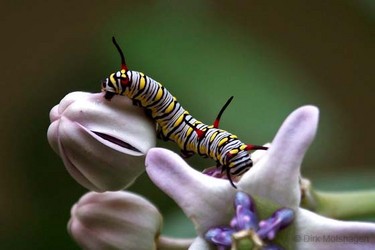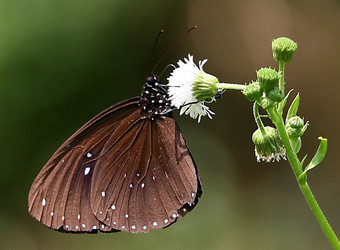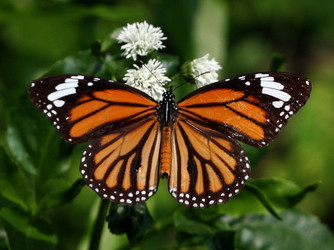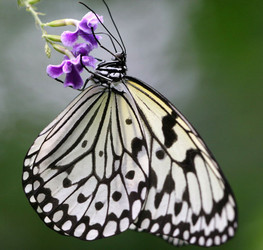Danaini
Milkweed Butterflies
Niklas Wahlberg and Andrew V. Z. Brower


This tree diagram shows the relationships between several groups of organisms.
The root of the current tree connects the organisms featured in this tree to their containing group and the rest of the Tree of Life. The basal branching point in the tree represents the ancestor of the other groups in the tree. This ancestor diversified over time into several descendent subgroups, which are represented as internal nodes and terminal taxa to the right.

You can click on the root to travel down the Tree of Life all the way to the root of all Life, and you can click on the names of descendent subgroups to travel up the Tree of Life all the way to individual species.
For more information on ToL tree formatting, please see Interpreting the Tree or Classification. To learn more about phylogenetic trees, please visit our Phylogenetic Biology pages.
close boxIntroduction
The Danaini (milkweed butterflies) are a pantropical group with their main area of diversification in southeast Asia and Australasia. One of the world's most familiar and widespread butterfly species, the monarch (Danaus plexippus), is a member of this clade. Virtually all species of danaines are aposematically-colored and are mimicked by other danaines as well as a wide range of palatable Batesian mimics in Nymphalidae, Pieridae and Papilionidae.
Characteristics
Adult male Danaini have eversible abdominal androconial structures called hairpencils that are a uniquely-derived synapomorphy among butterflies. Larvae are usually aposematic, and possess fleshy tubercles on at least the second and eleventh segments. All danaines sequester compounds from their larval host plants (cardenolides and pyrrolizidine alkaloids) that make them distasteful to predators.


Larva of Danaus chrysippus, Nigeria: Port Harcourt. © 2009 Dirk Motshagen
Discussion of Phylogenetic Relationships
The tree is based upon the morphological cladistic analysis of Ackery & Vane-Wright (1984) and largely corroborated by molecular data (Brower & Wahlberg unpubl.)
References
Ackery PR, and Vane-Wright RI. 1984. Milkweed butterflies. British Museum (Natural History), London.
Vane-Wright RI, Boppré M, and Ackery PR. 2002. Miriamica, a new genus of milkweed butterflies with unique androconial organs (Lepidoptera: Nymphalidae). Zoologischer Anzeiger 241: 255-267.
Title Illustrations

| Scientific Name | Euploea sylvester swinhoei |
|---|---|
| Location | Taiwan |
| Specimen Condition | Live Specimen |
| Source | IMG_7752al1 |
| Source Collection | Flickr |
| Image Use |
 This media file is licensed under the Creative Commons Attribution-NonCommercial-NoDerivs License - Version 2.0. This media file is licensed under the Creative Commons Attribution-NonCommercial-NoDerivs License - Version 2.0.
|
| Copyright | © 2006 leemt2 |
| Scientific Name | Danaus genutia |
|---|---|
| Location | Taiwan |
| Specimen Condition | Live Specimen |
| Source | IMG_6994al1 |
| Source Collection | Flickr |
| Image Use |
 This media file is licensed under the Creative Commons Attribution-NonCommercial-NoDerivs License - Version 2.0. This media file is licensed under the Creative Commons Attribution-NonCommercial-NoDerivs License - Version 2.0.
|
| Copyright | © 2006 leemt2 |
| Scientific Name | Idea leuconoe |
|---|---|
| Location | Taiwan |
| Specimen Condition | Live Specimen |
| Source | IMG_9343l1 |
| Source Collection | Flickr |
| Image Use |
 This media file is licensed under the Creative Commons Attribution-NonCommercial-NoDerivs License - Version 2.0. This media file is licensed under the Creative Commons Attribution-NonCommercial-NoDerivs License - Version 2.0.
|
| Copyright | © 2006 leemt2 |
About This Page
Niklas Wahlberg

University of Turku, Finland
Andrew V. Z. Brower

Middle Tennessee State University, Murfreesboro, Tennessee, USA
Correspondence regarding this page should be directed to Niklas Wahlberg at
niklas.wahlberg@utu.fi
and Andrew V. Z. Brower at
abrower@mtsu.edu
Page copyright © 2010 Niklas Wahlberg and Andrew V. Z. Brower
 Page: Tree of Life
Danaini . Milkweed Butterflies.
Authored by
Niklas Wahlberg and Andrew V. Z. Brower.
The TEXT of this page is licensed under the
Creative Commons Attribution License - Version 3.0. Note that images and other media
featured on this page are each governed by their own license, and they may or may not be available
for reuse. Click on an image or a media link to access the media data window, which provides the
relevant licensing information. For the general terms and conditions of ToL material reuse and
redistribution, please see the Tree of Life Copyright
Policies.
Page: Tree of Life
Danaini . Milkweed Butterflies.
Authored by
Niklas Wahlberg and Andrew V. Z. Brower.
The TEXT of this page is licensed under the
Creative Commons Attribution License - Version 3.0. Note that images and other media
featured on this page are each governed by their own license, and they may or may not be available
for reuse. Click on an image or a media link to access the media data window, which provides the
relevant licensing information. For the general terms and conditions of ToL material reuse and
redistribution, please see the Tree of Life Copyright
Policies.
- First online 25 September 2006
- Content changed 09 February 2010
Citing this page:
Wahlberg, Niklas and Andrew V. Z. Brower. 2010. Danaini . Milkweed Butterflies. Version 09 February 2010 (under construction). http://tolweb.org/Danaini/27571/2010.02.09 in The Tree of Life Web Project, http://tolweb.org/











 Go to quick links
Go to quick search
Go to navigation for this section of the ToL site
Go to detailed links for the ToL site
Go to quick links
Go to quick search
Go to navigation for this section of the ToL site
Go to detailed links for the ToL site